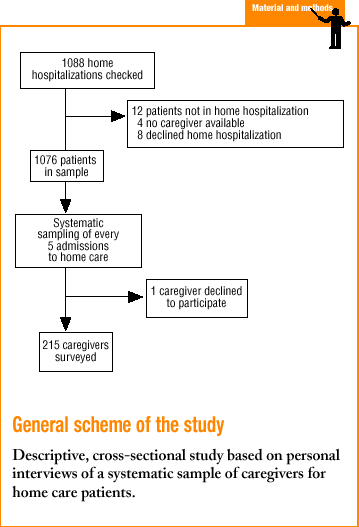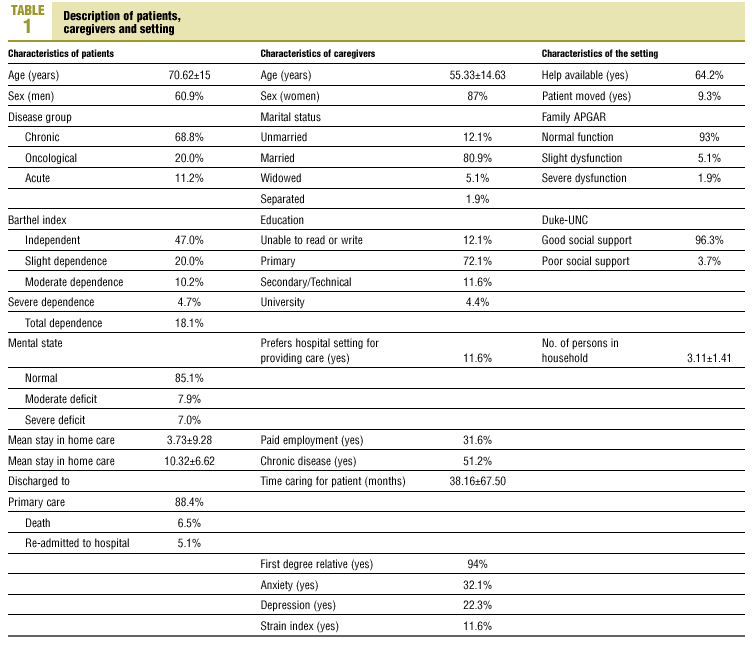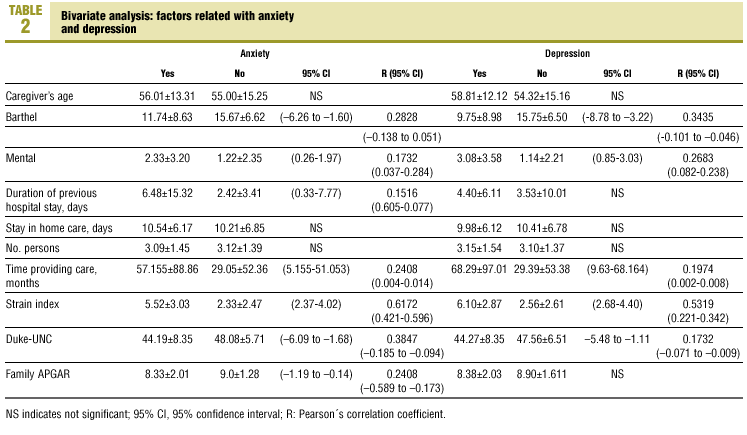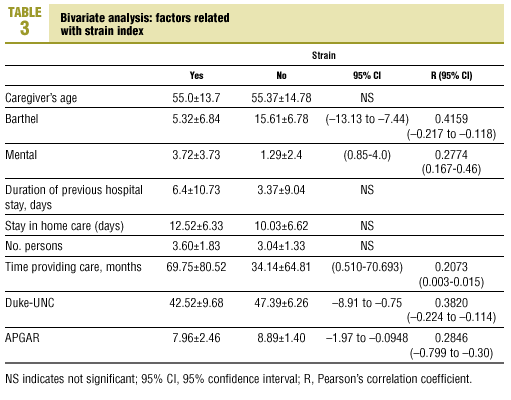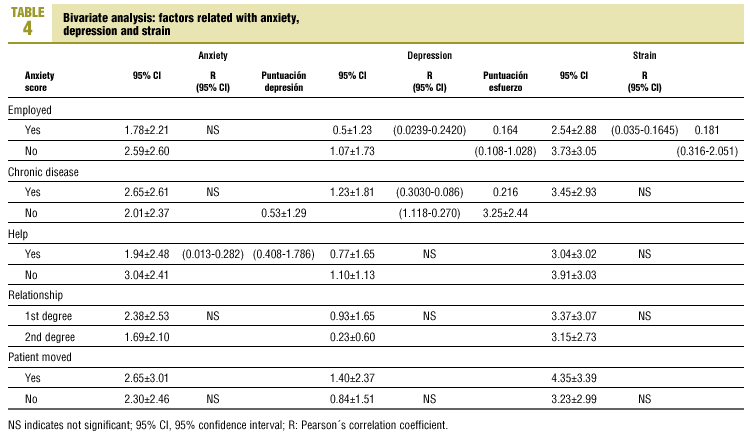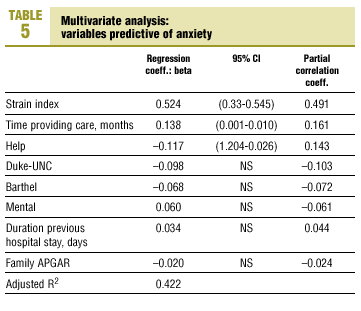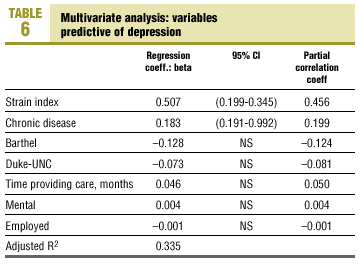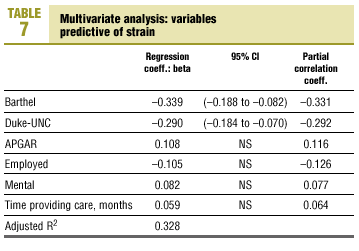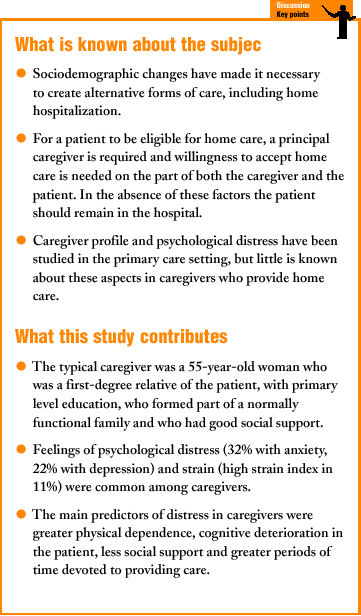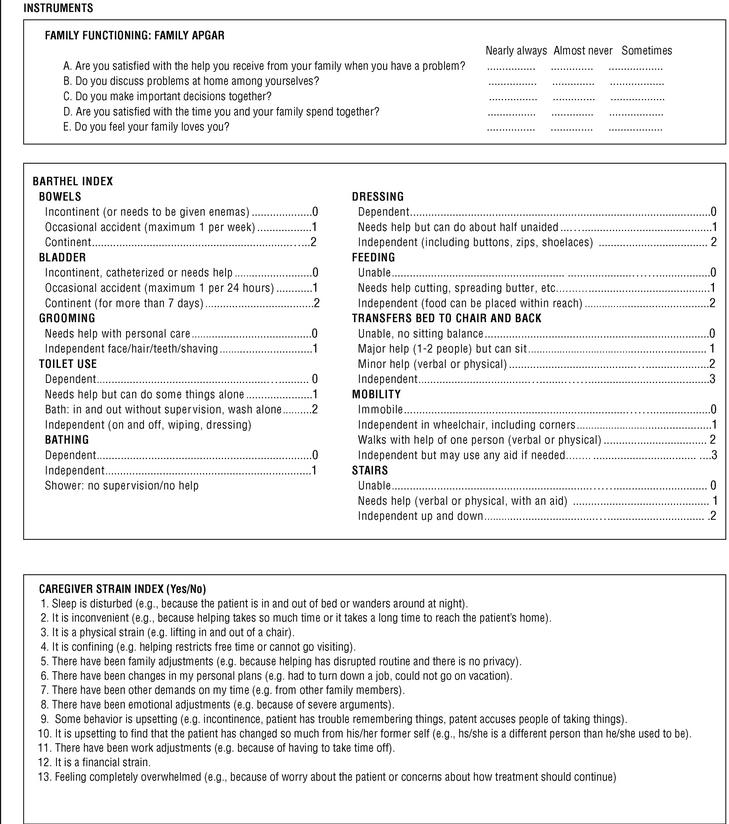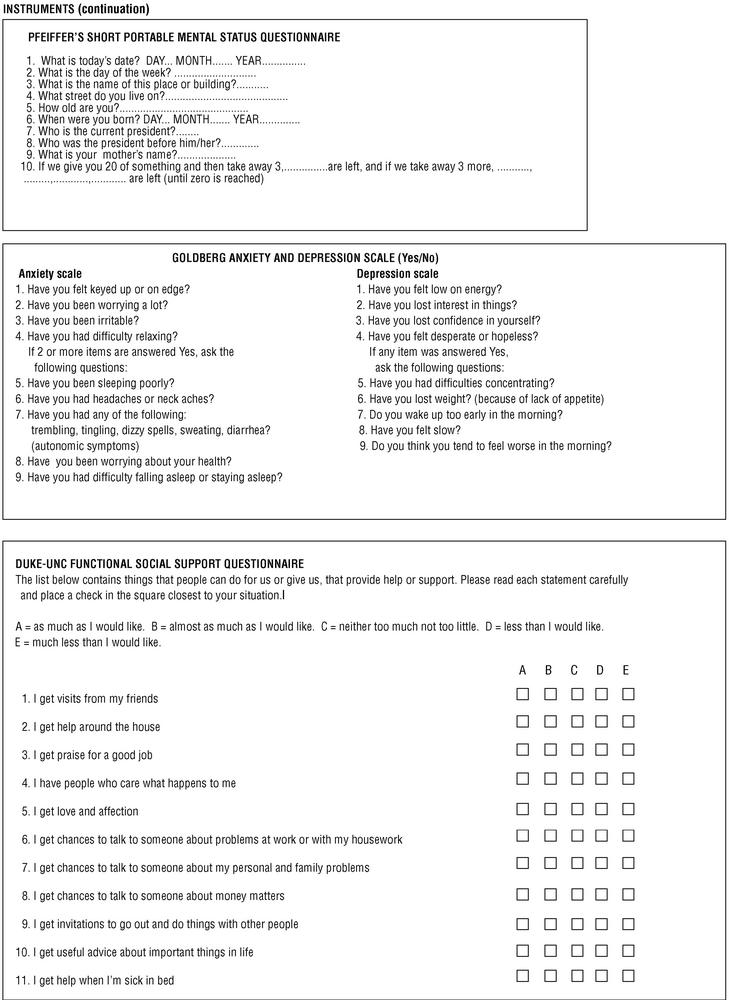Introduction
Sociodemographic changes in recent years have made it necessary to create alternatives to hospitalization, and one such alternative is home care. Patients are selected for home care (also termed domiciliary hospitalization) only if a principal caretaker is available, and both the caretaker and the patient are willing to use this alternative. If these circumstances are not present the patient should stay in the hospital.1
Caregivers for patients with cognitive impairment or a large degree of physical dependence have been widely studied within the setting of home care.2-5 Home care, with its differences in comparison to traditional hospitalization, greater use of hospital-range caregiving measures, and greater instability of the patient, requires a particular caregiver profile. Because a patient can be admitted to home hospitalization only if the caregiver´s profile is appropriate, home care managers at the hospital need to know the caregivers´ profile, and whether they are subjected to an excessive burden of care.
The aims of this study were to determine the profile of caregivers for patients in home care, to investigate the presence of mental illness and caregiver burden, and to analyze the factors associated with their degree of psychological distress.
Material and methods
The population for this descriptive cross-sectional study consisted of caregivers for patients in home care in Health Area 11 of the Community of Valencia (Eastern Spain). This coastal area comprises a large city and an otherwise mostly rural area. Large numbers of tourists spend time in the area, and there are many essentially permanent residents not included in the census (retired persons from other parts of Spain who spend most of the year near the seaside). The 1999 census lists 146 649 inhabitants, with a dependence index (ie, the population >=65 years+the population ¾14 years/the population between 15 and 64 years of age) of 0.47 and an aging index (population >=65 years/population ¾14 years) of 0.96.
Patients admitted to home care are referred from the hospital emergency service, from a regular inpatient ward (short-stay unit or regular inpatient area) and from primary care centers (no previous hospital stay). During the year 2001, a total of 1076 patients with a mean age of 71.0±15.4 years used home care, 59.4% of whom were men.
The study sample consisted of caregivers (persons directly responsible for the care of patients at home) who agreed voluntarily to participate in the study, and who provided home care between 1 January and 31 December 2001. Participants were chosen by systematic sampling of the caregiver who accompanied every fifth patient.
During this period home hospitalization was not provided for 12 patients, in 4 cases because no caregiver was available, and in 8 cases because the patient refused voluntary home care. Only one caregiver declined to participate in the study. The total number of caregivers who participated was 215.
The variables investigated are described below:
Patient variables
Age, sex, disease group recorded upon admission as relapse of chronic disease, patients with oncological disease receiving palliative treatment, or acute illness with no history of chronic disease.
Functional capacity was evaluated with the 20-point Barthel Index of Activities of Daily Living, and was classified as independent (score of 20), slight dependence (19-15), moderate dependence (14-10), severe dependence (9-5) or total dependence
(4-0).
Cognitive status was evaluated with Pfeiffer´s Short Portable Mental Status Questionnaire, and was scored as normal (0-4 errors), moderate cognitive impairment (5-7 errors) or severe cognitive impairment (8-10 errors). One point was subtracted if the patient had received only primary level education, and one point was added if the patient had completed secondary education.
Hospital stay before starting home care was recorded in days, as was the duration of home care. Referral upon discharge was recorded as primary care, admission to a hospital ward, or death.
Caregiver variables
Age, sex, and level of education, recorded in four categories as unable to read or write, primary level education, secondary level education or technical school, or university level education. Relationship with the patient was recorded as first degree (parents, children, spouse, sibling) or second degree (other). Marital status was recorded as unmarried, married, widowed or separated. Paid employment was recorded as a dichotomous (yes/no) variable. Time spent caring for the patient was recorded in months. Screening for psychological distress was done with the Goldberg Anxiety and Depression Scale. Symptoms that lasted more than 2 weeks and those in which a clear response was obtained were scored as positive. Anxiety was considered present when the score was >=4, and depression was recorded when the score was >=2. The 13-item Robinson Caretaker Strain Index was also used; each positive response was scored one point, and the caretaker was considered to have high level of strain if the total score was >=7. Chronic illnesses were recorded as headache, backache (cervical, dorsal or lumbar), chronic venous insufficiency, or nonspecific muscle pain (yes/no). Caregivers´ preference regarding place of work was recorded as their response to the question «Do you think you would have done your job as caregiver better in the hospital than at home?»
Family environment variables
The degree of satisfaction with family functioning was evaluated with the self-administered Family APGAR Scale. Items were scored on a 0-to-2 Likert scale, and total score ranged from 0 to 10. Scores >=7 were considered to indicate normal functioning, 4-6 slight dysfunction, and ¾3 severe dysfunction. Social support was evaluated with the self-administered Duke-UNC Functional Social Support Questionnaire. Items were scored on a 1-to-5 Likert scale, with total scores ranging from 11 to 55. Scores ¾32 were considered to reflect low social support. Total number of persons in the household was noted. Help received by the caregiver was determined as the response to the question «Do you receive help in caring for the patient from an older son or daughter, the social services, or a private home care assistance service?» Whether the patient stayed at the home of more than one relative was also noted.
Data collection
Patient-related variables were recorded from the medical record, and information on other variables was obtained by face-to-face interview at the patient´s home. On the first day of home care the caregivers were given information about the study, and an appointment was scheduled for a future date during the period of home care, once the caregiver had adapted to the home. To avoid bias, all interviews were done by three researchers previously trained in roll-play sessions in the administration of the questionnaire.
Data analysis
The data were imported in the Microsoft Excel 2000 spreadsheet and analyzed with version 9.0 of the SPSS for Windows.
Statistical analysis was done in three phases:
1. Univariate analysis: frequency distributions for qualitative variables, and central tendencies and dispersions for quantitative variables.
2. Bivariate analysis was done to compare the results for qualitative variables with the chi-squared test; strength of association was determined by calculating the odds ratio and 95% confidence interval. For comparison of the means, normal distribution was confirmed with the Kolmogorov-Smirnov test and equality of the variances was tested with Student´s t test or Mann-Whitney´s U test. The degree of association between quantitative variables was determined with Pearson´s correlation coefficient or Spearman´s rho.
3. Variables that had an overall influence on mental illness and caregiver burden were identified with multiple linear regression with the enter method for three dependent variables (anxiety, depression and strain), using as predictive variables those that yielded significant results in the preceding bivariate analysis.
The results were considered statistically significant at P<.05.
Results
The characteristics of the 215 caregivers studied here are summarized in Table 1. Our analysis of the factors related with anxiety, depression and strain (Tables 2, 3, and 4) showed that a higher risk for these problems was associated with greater physical dependence and mental impairment in the patient, less social support, and longer periods spent caring for the patient. The risk of anxiety and depression was greater with higher strain index values, and anxiety and strain increased with the degree of family dysfunctioning. Lack of paid employment was associated with greater depression and strain; chronic illness was associated with depression, and lack of help with caregiving was associated with anxiety.
Multivariate analysis with all predictor variables shown in Tables 5, 6 and 7 accounted for 42.2% of the variability in anxiety, 33.5% of the variability in depression, and 32.8% of the variability in strain index.
For anxiety, 24.10% of the variability was found to be significantly dependent on strain index, 2.59% on time spent caring for the patient, and 2.05% on whether any help was received in caring for the patient. For depression, 20.79% of the variability was explained by the strain index and 3.96% by whether the caregiver had a chronic illness. Variability in the strain index was influenced by physical disability in the patient according to the Barthel scale (10.95%), and by social support (Duke-UNC) (8.53%).
Discussion
Any evaluation of our results should consider the selection criteria we used in this study. The 12 patients who did not enter home care because of the lack of a primary caregiver or because of motives that the caregiver did not specify may represent cases with the greatest burden of care, involving patients who should remain in the hospital. Another limitation is the rootedness of the population in our area of study, where family networks are an important source of support. (Only one caregiver, a retired person, was from a region outside the study area and had moved to the region where the study was carried out). Because of these factors, and the variety in the degrees of mental illness, disability and time spent caring for the patient, our results should be extrapolated to other populations with caution. With regard to the instruments we chose, all have been validated for use in Spain except for the strain index, but we feel that their use in many other published studies justifies their choice for the present study.
The caregiver profile in our study was similar to that found in earlier reports.2-11 Typically, the caregiver was a married, middle-aged women, a first degree relative of the patient, with primary level education. Caregivers who are relatives of the patients are a risk group for mental illness,6 and have been considered «hidden patients».5
Earlier studies have reported percentages of anxiety ranging from 45% to 80%;2,6-9,12 in the present study anxiety was found in 32% of the caregivers. The corresponding values for depression ranged from 16% to 60%,2,7,9,12 with a frequency of 22.3% in the present study. The strain index reported by other authors ranged from 27.8% to 60%,2,3,7 and was 11.6% in the present study. These findings may be explainable in part by the «protective» effect of home care on the caregiver, despite the fact that the patient requires more intensive care because of his or her unstable condition, or because the care measures provided are similar to those available on a hospital ward.
Our results after bivariate analysis were similar to those of earlier studies. The degree of mental distress in caregivers was associated with the patients´ degree of physical disability,5,10,13 the time devoted to caregiving,2,10,13 a high strain index2,7 and chronic disease in the caregiver.2 Other studies have shown that depression in the caregiver is associated with lack of support.7
In earlier studies that included regression analysis, caregiver anxiety and depression were found to be correlated with score on the daily living activities index and the patient´s mental status.5 Availability of help with caregiving and being a relative of patient were associated with anxiety scores.11 We do not feel that these findings should be considered discordant from ours, as we found that the variable with the greatest impact on anxiety and depression was caregiver strain, a factor that was not measured with the index we used, as such, in the two studies cited above.
Because of the limitations discussed above, our results do not allow us to claim a causal relationship between anxiety or depression and predictive factors. However, they should help encourage the systematic collection of information regarding caregivers´ social support (Duke-UNC questionnaire) and strain index in all cases of home care. Moreover, recognition of psychological distress in the caregiver is useful in itself. Caregivers may benefit from the mobilization of resources to counteract, in part, the burden of care. Patients may recover more quickly or enjoy a better stay in home care if the caretaker is not subjected to distress. The health care team may be better informed about the support resources available to caregivers to ensure continuity of care and treatment. The hospital and other units that refer patients to home care may be able to discharge patients sooner and with greater assurances that the patient will not need to be readmitted because of withdrawal of family-provided care.
Acknowledgements
We thank all patients and their caregivers who took part in this study for their cooperation during the data collection phase. This study was made possible thanks to the financial support of the AISSA (Asociación para la Investigación Sanitaria en la Comarca de la Safor) Foundation.
Correspondence: M. Sol Moral Serrano C/ Madrid, 23, 5.º 9.ª. 46700 Gandía (Valencia), Spain. E-mail: padisol@hotmail.com
Manuscript received 4 September 2002.
Manuscript accepted for publication 8 January 2003.
This study was financed by the AISSA (Asociación para la Investigación Sanitaria en la Comarca de la Safor) Foundation Prize awarded to the best research project for the year 2000.







